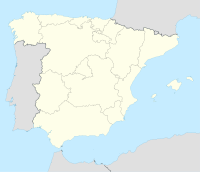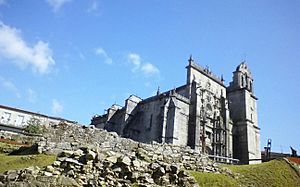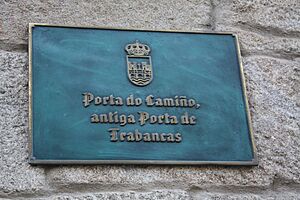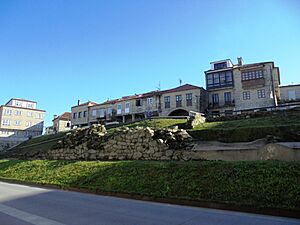Walls of Pontevedra facts for kids
Quick facts for kids Walls of Pontevedra |
|
|---|---|
| Muralla de Pontevedra | |
| Pontevedra, Spain | |
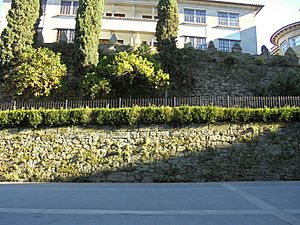
Walls of Pontevedra remnants in Arzobispo Malvar Street
|
|
| Coordinates | 42°26′02.0″N 8°38′51.0″W / 42.433889°N 8.647500°W |
| Type | Walls |
| Height | Up to 7 m (23 ft) |
| Site information | |
| Owner | City of Pontevedra, Spain |
| Condition | Remnants |
| Site history | |
| Built | 12th century – 15th century |
| Materials | Granite |
The walls of Pontevedra were strong defenses that once surrounded the city of Pontevedra in Spain. Most of these walls were taken down in the late 1800s. However, you can still see some parts of them today. The most important part is a section with battlements (the top part with gaps for defense) on Arzobispo Malvar Street. This section is about 40 meters long. You can reach it from the gardens near Santa María Avenue.
Other parts of the walls are now inside newer buildings. For example, a piece near the old Trabancas Gate was kept and shown off when the Savoy café was renovated.
Contents
A Look Back: The Walls' Story
How the Walls Began
The very first wall around Pontevedra was built in the 1100s. The main walls we talk about began to be built in the 1200s. Their goal was to protect the city. Building continued through the 1300s and finished in the 1400s. The walls stayed the same for about 400 years. Historians believe the walls were made bigger three times. The first time was between 1300 and 1325. The last time was between 1450 and 1480.
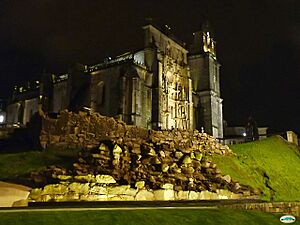
The first wall likely covered the area around the Basilica of Saint-Mary Major. The city grew a lot because of fishing. In 1229, Pontevedra got special permission to dry and sell fish everywhere. In 1238, it was the only place allowed to make fish oil. More people moved in, and a new church area was created. This made the city's shape change from almond-like to almost round.
The second time the walls were made bigger was between 1300 and 1325. The city kept growing. This led to religious groups building convents like Saint Dominic, Saint Francis, and Saint Clare. Even though these were outside the city, they showed how many people lived there.
The third time the walls were expanded was in the mid-1400s. This included the Saint Francis convent. There were three reasons for this growth:
- Wars: The time was often warlike, so better defenses were needed.
- Growth: The city was getting richer and had more people.
- New Spaces: The city needed more room because King Henry IV of Castile allowed the special Feira Franca (a tax-free fair).
Why the Walls Disappeared
Over time, the city faced fewer attacks. This meant the walls were not as important anymore. As military technology improved, the old walls became outdated. An attack by the English in 1719 also damaged them a lot.
In the mid-1800s, the city council decided to take down the walls. They wanted the city to grow and look more modern, like other European cities. The walls were seen as old-fashioned.
The work to remove the walls happened between 1848 and 1886. The Trabancas Gate was the first to go. This gate was between the Plaza de la Peregrina and the Plaza de la Herrería. Then came the Santa Maria Gate in 1852, followed by the Galera Gate. The St. Dominic's Gate was taken apart in 1854. It was later moved to the old St. Francis convent and used as its main entrance.
Other parts were also taken down. These included the Bastida Tower, the Golden Tower, and the defenses near the Burgo Bridge. The Archbishops' Towers were already in ruins from the 1719 attack. They were finally removed in 1873.
The Walls Today
Today, only small parts of these old defenses remain. You can see a section with battlements on Arzobispo Malvar Street. There are also other old pieces found during building work. These include parts near the Basilica of Saint-Mary Major and on Sierra Street. This part is now inside the Castelao Building of the Pontevedra Museum.
In the 2000s, during city renovations, more parts of the medieval wall were found. These pieces have been studied and fixed up. They are now part of the city's history. The most important ones are on Arzobispo Malvar Street. They are now part of the city landscape with paths and grassy areas. You can also see parts inside the Castelao building of the Pontevedra Museum. These parts are on the north side, close to the Lérez River.
Other wall pieces have been found inside buildings. For example, you can see them at the side of the Café Savoy. Also, at 20 Michelena Street, a tapas bar called La Muralla has a piece of the wall in its basement. It's now a cool part of the bar's design!
What the Walls Looked Like
The fortified area was built around two hills. One had the Basilica of Saint-Mary Major to the west. The other had the convent of St Francis to the east. The wall was made of stone and was about 7 meters (23 feet) high. It had battlements on top and a walkway for guards. This walkway was 2 meters (6.5 feet) wide. The walls had many towers and defenses. They stretched for about 2,170 meters (7,120 feet) in total. The most famous tower was the Bastida Tower. It stood where the city hall is today. Outside the wall, there was a ditch or moat.

The city walls had 4 large gates and 7 smaller openings. The four main gates were connected to the main roads leading to Santiago, Orense, Tuy, and Marín. These gates were:
- St. Mary's Gate: Located near the Basilica of St. Mary Major.
- St. Dominic's Gate: Close to the Dominican convent, now the ruins of St. Dominic's. It connected to the fishing area of A Moureira.
- Trabancas Gate: Linked the Herrería square with the Pilgrim Virgin Square.
- Rocheforte Gate: Opened onto Santa Clara Street, where the Gothic convent of the Poor Clares is. It connected to the Camino de Castilla.
There were also other gates, like the Galera and Ribeiro gates. The Bridge Gate was next to the Burgo Bridge. The Baron Gate was near the Palace of the Counts of Maceda, which is now a hotel.
Along the walls, there were also fortified towers. These included:
- The Archiepiscopal Towers: Near the Basilica of Saint Mary Major.
- The Gold Tower: In the northern part of the walls. It was named because it looked like the Gold Tower of Seville.
- The Bastida Tower: A defense tower where the Pontevedra City Hall is now.
- Two more towers between the Trabancas and Rocheforte gates.
- Two towers on the banks of the Lérez River.
Today, during the Feira Franca festival, the main gates of the old walls are recreated. This medieval festival happens every year in early September. It celebrates the tax-free fair given to the city by King Henry IV of Castile in the 1400s.
How the Walls Shaped the City
After the walls were built, the city could only grow inside them. This limited the size and even height of buildings. Buildings with more than three floors were seen as a risk to the city's defense. The main gates of the walls also set up the city's main roads. These roads connected Pontevedra to all directions.
What the Walls Were For
The walls had several jobs. They protected against enemies. They also helped control diseases by not letting sick people enter.
But the most important job was to control goods coming into the city. This was how the city collected taxes. Two main products of Pontevedra's economy were wine and sardines. These goods had to follow specific routes.
Wine could only enter through the Saint Clare gate. This gate connected to the old Castilian Way. Mule drivers brought wine from Avia on their mules. The Trabancas Gate connected the Plaza de la Herrería to the Portuguese Way. This route was used for wine from the Lower Minho region. Carriers used carts pulled by oxen for this.
Fish merchants also had specific gates. The Ribeiro gate was near the Burgo Bridge. Mule drivers carried dried fish in baskets to the countryside. This way of controlling trade by land was very effective. In 1594, the tax collectors even demanded that the city keep this old system.
See also
 In Spanish: Muralla de Pontevedra para niños
In Spanish: Muralla de Pontevedra para niños
Related articles
- Old town of Pontevedra
- Plaza de la Peregrina
- Pontevedra Museum
- Archiepiscopal Towers Interpretation Centre


